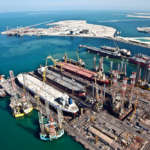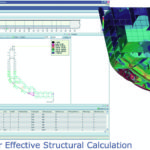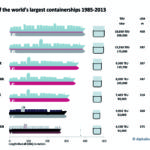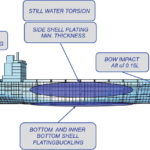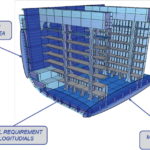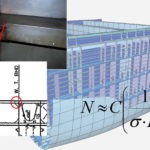A revolution of global transportation – and a look into the future. Part one: technical developments and classification rules.
A groundbreaking invention
When, over 55 years ago, the American truck owner Malcolm McLean developed the idea to[ds_preview] design a unitised transport container that was also able to sustain the forces of a sea passage, he was probably not aware of the revolution he was going to trigger. Containers for transporting goods on railways and trucks had already been known for quite some time. The first mention of standardised boxes was even made in the 18th century in connection with the UK’s coal mining industry. But the main advantage of a standard box was the »breaks of gauge« because different transport systems with different dimensions could be used.
However, it still took almost ten years for the idea to materialise worldwide. Sea-Land Corporation, the American liner company established by McLean, inaugurated its first full container line between New York and Europe in the spring of 1966. The first ship to arrive in Bremen with a full load of containers (at the time 35’ long) that same year was the »Fairland« (see HANSA 08/2006). To build a solid box with standard dimensions was one thing – it was quite another to design the right vehicles for its transportation. Ships in the 1950s and 1960s were constructed with a high degree of understow for stability reasons.
Another factor was the intake of the 20’ x 8’ x 8’6” (alternatively 40 ft long) units. Some vessels – like the German »Tramko Type« – were at a great disadvantage in the beginning of the container era when they lost one tier under deck and thus appeared to be uninteresting to the increasingly prevalent container liner trade.
Apart from the necessity to construct purpose-built container ships, seaports also had to take on the challenge of preparing for the advanced handling of boxes ashore. The obvious advantage of this timesaving investment eventually led to a global change of parameters. Port authorities and owners that made an early decision to join the box-community also experienced an early return on their investments in view of the unbelievably fast development of this trade. They were also ahead of those that had decided to initially avoid that risk. Soon full container ships appeared on the market, purpose-built to only carry standard boxes.
Due to economies of scale, the intake has grown from a few hundred in the 1960s to 15,000 or even 18,000 TEU today. Some say that the size of container ships is only limited by the depth of the Straits of Malacca (max. allowable draught 21 m), which is one of the world’s busiest shipping lanes and links the Indian Ocean to the Pacific Ocean. This so-called »Malaccamax« size constrains a ship to dimensions of 470 m (1,540 ft) in length and 60 m (200 ft) in width*. The design of vessels for the Pacific liner trade was affected by the decision to expand the dimensions of the Panama Canal in order to accommodate bigger ships in the future.
More large ships are expected to enter the maritime scene. Statistics show that about 90 % of non-bulk cargoes worldwide are moved by containers. Taking into account the current global population of seven billion, the shipping of consumer goods may grow to unknown heights.
Two main factors fuelled the exorbitant development of shipping. Firstly, fast growth in worldwide trade could be observed after World War II. Living standards in the industrialised countries also improved rapidly and resulted in more exchange of manufactured products. Simultaneously, the skills of well-educated and able shipbuilding engineers and the emergence of the computer era resulted in ship designs and ships being built with increasingly large dimensions in order to meet the growing demands of the trading industry. The adoption of »finite element calculations« in ship designs was a considerable breakthrough. This enabled shipbuilders to construct vessels with large hatch openings or even without hull stabilising hatch covers.
Global turbulence affecting the shipping industry
The shipping industry is a permanently changing business. Huge investments in large and purpose-designed newbuildings always face unforeseen risks. The big financial and economic crunch in the end of 2008 heavily affected the global shipping market and especially the container sector. As a result, the industry considerably revised its general view. Besides, the growing environmental concerns about operating ships and the exorbitant rise in fuel costs forced shipowners to radically rethink their policies. The laying up of ships during the crisis as well as the option of slow steaming enabled most of the industry to survive the crash – in spite of some bruises. A large number of newbuildings were cancelled and the delivery of others was considerably postponed. In view of this extraordinary experience, shipowners are now ready to make new and to some extent radical changes to ship designs and not just order bigger ships.
The challenge of the rapid growth in ship size
The rapid growth of container ships is due to »economies of scale«. Simultaneously, there are substantial technical challenges that have to be solved. The lifetime of a seagoing vessel is usually calculated to last about 25 years, depending on the type and area of trade. Regular North Atlantic passages, for example, cause different stresses and forces acting on a ship than the operation of a ship in calmer waters.
Experience with large ship designs has been gained over the last fifty years, when bulk carriers went through a similar process. New ship designs always have to bridge the gap between the ship operator’s economical demands on the one hand and the physical and regulatory limits on the other. Going to the limits always entails controllable risks which have to be minimised but they can never be completely eliminated. Tools to help calculate the risks involved had to be developed. At least they indicate when and where danger or damage can be anticipated.
The basis for controlling risks is to optimise the ship’s design and structure. Completely new designs require new rules in order to cover all possible risks and uncertainties. Empiric formulas and new tools had to be and must further be developed, enabling engineers and ship builders to find the right balance between the construction characteristics. Evaluating accidents like the one involving the »MSC Napoli« in 2007 can also give valuable information to the shipbuilding industry about hidden deficiencies in a ship design that must be avoided in future constructions. As a result of the investigation by DNV and MAIB after the accident, all IACS class rules were amended and upgraded to better cater for extreme wave loading, thus ensuring overall global integrity.
When looking at a new ship design, ship operators always focus on the use of a minimum of material in order to keep the vessel as light as possible. For this purpose, rules have been gradually developed by classification societies over the last approximately 150 years. Particularly the change of construction materials (such as from wood to steel at the end of the 19th century) required the introduction of a complete set of new rules. The classification societies had to take over huge responsibilities when classifying entirely new designs merely on the basis of calculations and empirical estimates. It was dangerous to come too close to physical limits in so far unknown spheres. Consequently, engineers followed the »safety first« idea and dared to go ahead in only fairly small steps.
The reality in container shipping has changed considerably during the last few years. The use of computer programs since the 1960s made it much easier to foresee certain risks and the endurance of a vessel and its components. Based on practical experience, the rules and calculations are constantly being refined and updated to comply with the latest standards. However, the rapid growth in the size of container vessels has challenged classification societies to constantly develop newbuilding rules to suit the new conditions. Despite the highly qualified computer tools and scientific models available today, the real behaviour of a huge vessel in laden or ballast condition must still be proven by practical experience.
Accommodating the structural design
DNV has monitored and analysed damages to container ships over a long period of time. Some two thirds of the container ships classed by DNV were designed and constructed according to the class rules of other societies. Thus it has been possible to gain comprehensive experience during service that has given valuable input to the development of DNV class rules for newbuildings. The development of building rules is aimed at:
• using the minimum amount of material necessary in order to make the ship as light as possible
• the most precise calculations of a vessel’s structure/load assumptions
• assessing the practical experience/various rules
• evaluating accommodative areas on the basis of the experience with vessel operations over a long period
• ensuring a safe and reliable ship during operation.
The focus has been on evaluating the following ship elements:
• shell
• aft ship
• bottom structure
• bow
Due to comprehensive advancements in the building rules, the following new elements were included or have been considered in more detail:
• still water torsion
• stern slamming
• side shell fatigue
• bottom and inner bottom shell plating buckling
• bow impact
• wave breaker
• connection & welding area
• local requirements longitudinal
• minimum thickness CL girder
These also revealed areas with limited damage experience where older rules were too conservative compared with the industry standard. This meant, for example, that the side shell thickness, minimum thickness of L-bars and section modulus requirement of inner bottom longitudinals could be reduced. Furthermore, the buckling requirements for outer bottom plating at mid of hold could be reduced. As a result, there have been several adaptations to the dimensions of important elements. The consequent assessment of the investigated areas has led to a higher degree of safety combined with weight optimisation.
Fatigue as a permanent challenge
The special characteristics of the container ship’s hull, with its wide open hatches, hull torsion etc. can lead to alternating stress on the structure. Depending on the construction of the hull, cracks are apt to appear after a certain period as a result of material fatigue. Although these defects may be quite common in older designs, the repairs are still time consuming and expensive.
An evaluation of damage statistics carried out by DNV for the 2005 to 2008 period showed that side shell cracks were the second most frequently occurring effect. Similar damage could be observed some ten to fifteen years ago on the hulls of tankers.
In particular, the risk of fatigue cracks appearing in the longitudinal side frames of the container ships’ hulls has to be monitored on older designs which have not been designed to have a satisfactory life time. DNV has introduced a new survey arrangement called Hull PMS (hull planned maintenance system). This enables surveyors to make use of the inspection results and documentation that ship managers keep on board. Side shell fatigue appears particularly on older container vessels. The method of forecasting possible damage based on regular records and the experience and special conditions of the trade can substantially reduce unexpected loss of time and high expenses. Recently, a ship was transferred from another class to DNV with side shell fatigue crack problems about four and a half years after delivery, prior to the first class renewal survey. By adopting Hull PMS, the ship owners were able to timely solve the problem and avoid the cost of more comprehensive repairs and possible time off hire.
The expected fatigue life can be calculated and provide guidance on the inspection frequency.
High tensile materials
The permanent growth in vessel size also requires higher standard materials. Current designs use materials like HT 47 in order to save weight and keep the dimensions of strength members at an acceptable level. The processing of such materials creates some substantial problems. It is therefore necessary to exploit the experience gained from the offshore sector, where even higher tensile materials are employed. Simultaneously, the building rules must be adjusted and it is important to support expertise on site if such materials are applied.
A matter of research & development: whipping
Wave-induced hull girder vibrations arising from bottom slamming or bow flare slamming are called whipping. These can considerably increase the extreme wave load and lead to cracks in important strength members. DNV has issued guidelines in order to control this phenomenon. Various joint industrial projects are running in this field and model tests are being carried out. Full-scale measurements are being conducted together with leading shipyards and owners on 2,800 TEU, 4,400 TEU, 8,600 TEU and 13,000 TEU vessels in order to essentially enhance the knowledge in this area with the goal of reducing the risk of such damage occurring.
Looking into the future
DNV has introduced a couple of conceptual ideas in the Quantum study (see Hansa 08/2010). Demands are becoming more individual and more complex. Modern container ships are no longer merely optimised to meet a certain design aspect, such as full speed and maximum draught, they must achieve good results in a comprehensive spectrum of draughts and service speeds. The aim is to provide fuel savings for each individual trade as an essential mark of quality. In this connection, CFD analysis is a valuable tool that allows the pre-calculation of the hull’s resistance and compares different results. This method of approach deviates from the well-known standardised designs of the past and will lead to individually shaped ship hulls in the future.
Summary
As a result of comprehensive evaluations and the assessment of the damage statics of vessels in service, DNV has augmented the building rules for container vessels and is meeting the industry’s demand for the highest quality. Consequently, the loads for calculating the required use of materials have been revised in order to provide a minimum lightweight for the design by simultaneously stipulating state-of-the-art standards for the design’s staunchness and giving the vessel enduring value. Further tools have been developed for the renowned Nauticus software and these enable the user to assess automatic load assumptions through user-friendly additional calculations, for example to evaluate expected fatigue cracks. The results have been comprehensively confirmed by practical experience.
For DNV, the gathering of information, recording of its long experience and extraordinary efforts made in the last few years to develop the rule basis for container ships too have all paid off.
DNV has been acknowledged as a reputable classification society and this has been proven in 2011: It has been able to increase its market share for container vessels to 19 % during the first three quarters (ships ordered from January until October 2011), with 35 container ship newbuildings ordered to DNV class.
Frank Hensel






